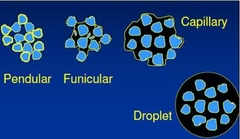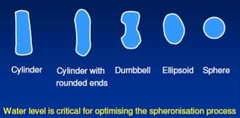![]()
![]()
![]()
Use LEFT and RIGHT arrow keys to navigate between flashcards;
Use UP and DOWN arrow keys to flip the card;
H to show hint;
A reads text to speech;
37 Cards in this Set
- Front
- Back
|
What is trajectory segregation? |
Where larger particles travel greater horizontal distances than smaller particles |
|
|
What is Elutriation Segregation? |
Where very small particles sediment on top of the larger particles |
|
|
What is Percolation Segregation? |
Where smaller particles drop to the bottom of the powder bed (as in hopper where movement of particles can take place) |
|
|
What are the nine reasons for granulation? |
-Improves powder flow -Provides a uniform mix of powders -Increases density of powder mix -Reduces risks of dust generation -Reduces risk of caking of hygroscopic powders -Dosage form -Intermediate for tabletting/capsulation -Helps compaction of powder mix -Aid wetting of particles |
|
|
What happens during wet granulation? |
-Powders mixed -Liquids added in granulation process -Aggregation of primary powder particles to form granules -Wet mass forced through sieve, producing wet granules -Drying -Milling -Screening |
|
|
What two type of liquids are used during wet granulation? |
-Granulating fluid -Binder |
|
|
What are the features of granulating fluid, and which solvents are used? |
-Solvents: water, ethanol, isopropanol -Compatible -Non-toxic -Removable by drying |
|
|
What does the binder do? |
Helps particles adhere together after drying |
|
|
Particle-Particle Interaction during Wet Granulation |

|
|
|
What is the pendular state? |
-Low liquid levels, discrete liquid bridges at points of contact between particles -Assumption that there is a uniform distribution of liquid throughout powder bed |
|
|
What is the Funicular state? |
–Further liquid content, pendular bonds coalesce and liquid bridges form between non-touching points–Dependant on degree of liquid (or voidage) saturation, usually 25-80% |
|
|
What is the Capillary state? |
-Liquid saturation > 80% -Granule becomes paste-like and unsuitable for wet sieving-Tensile strength of granule increases x3between pendular and capillary state |
|
|
What is the Droplet state? |
-Further increase in liquid converts capillary state into droplet state (undesirable)-Particle completely enclosed in water droplet and mass takes on slurry like properties |
|
|
How many stages of bridge formation are there? |
Four |
|
|
How does adhesion take place during dry granulation? |
Due to pressure |
|
|
How does adhesion take place during wet granulation? |
Particles adhere due to liquid |
|
|
What are the three phases of agglomeration? |
-Nucleation -Transition -Ball Growth |
|
|
What happens during Nucleation? |
– Particle-particle contact and formation of liquid bridges– Further agitation densifies pendular state which acts as a nuclei for further granule growth |
|
|
What happens during Transition? |
-Nuclei can grow by single particles being added via pendular bridges or two or more nuclei can combine– Wide size distribution exhibited |
|
|
What happens during Ball Growth? |
– Further granule growth produces large, spherical granules with size increasing over time.– Agitation stopped (would promote further coalescence making over-massed particles) |
|
|
How are solid bridges formed? |
-Partial melting -Hardening binders -Crystallisation of dissolved materials |
|
|
What happens during Partial Melting? |
–Pressures used in dry granulation may cause melting of low melting point materials –Crystallisation of the materials helps bond the particles together when the pressure is relieved |
|
|
What are Hardening Binders? |
-Binders used in granulating fluid harden or crystallise on drying–Synthetic polymers and pre-gelatinised starch |
|
|
What happens when dissolved materials are crystallised? |
–Some of the powders in the mix may besoluble and dissolved in the granulating liquid–Crystallisation of the dissolved substancesmay happen when the granules are dried eg. Lactose–Slower drying times result in larger crystals |
|
|
What are the advantages of wet granulation? |
–Reduced segregation of formulation components during storage/processing–Useful for formulation of tablets with low active ingredient concentrations–Uses conventional excipients–Can be post-processed (tablet coating) |
|
|
What are the disadvantages of wet granulation? |
-Several processing steps needed-Solvents used in process lead to concerns i.e. stability of drugs, toxicology of formulation |
|
|
What are the features of Dry Granulation? |
-No liquids -Suitable when product is moisture and heat sensitive and can't be compressed after wet granulation -Aggregation of primary powder particles to form granules under high pressure |
|
|
How are compacts broken up into granules during dry granulation? |
A mill/slugging is used |
|
|
What is Slugging? |
A process used to compress dry powders into a large oversized tablet (slug) using a large heavy press. |
|
|
What happens during Slugging? |
-Dry powders compressed into tablet around 25mm in diameter, and 10-15mm thick. -Large heavy duty press is used -Binder used to improve bonding strength during compaction -Disintegrant used as excipient -Lubricant added to prevent compacts sticking to the punches and die |
|
|
What happens during roller compaction? |
– Dry powder mix squeezed between two rollers to form compressed sheet– Brittle sheet immediatley broken into flakes or milled into correct size– Flakes turned into granules– Can be compacted with binder to improve bonding strength– Roller compaction required less lubricant than for slugging |
|
|
What are the different types of excipients used in granulation? |
-Diluents -Disintegrants -Binders -Lubricants -Glidants |
|
|
What are the advantages of dry granulation? |
-Both roller compaction and slugging require conventional excipients–Methods not commonly associated with degradation/alteration of drug molecules during processing-No heat or solvents required |
|
|
What are the disadvantages of dry granulation? |
–Roller compaction requires specialist equipment–Segregation of components may occur post processing–May be issues regarding powder flow–Final tablets usually softer than with wet granulation |
|
|
What are the different types of wet granulators? |
-Low shear mixers -High-speed granulators -Fluidised-bed granulators |
|
|
What is Spheronisation? |
-A form of granulation -Makes uniform sized spherical pellets -Used when spheres required dosage form -Useful for M/R and C/R forms -More labour intensive -Wet massing important to produce good quality spheres |
|
|
Transition from rod-shaped to spherical particles |

|

